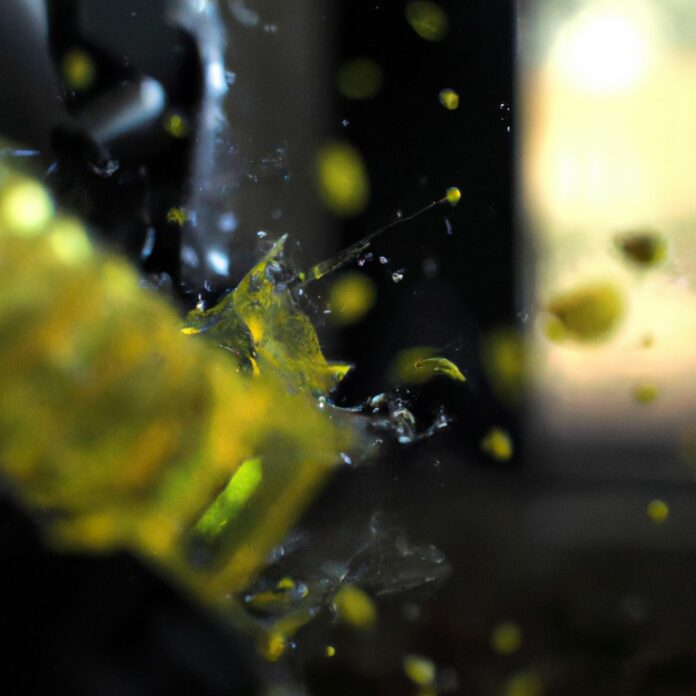Paintball is a popular recreational activity that involves shooting paint-filled pellets using specialized guns. However, when it comes to playing paintball near glass surfaces, you may wonder about the potential risks and whether paintball guns have the ability to break glass.
In this article, we will explore the impact of paintball guns on glass and provide insights into the factors that determine the ability to break glass.
To understand the relationship between paintball guns and glass, it is essential to have a basic understanding of paintball guns themselves. We will delve into how paintball guns work and the different types available in the market.
The main question addressed in this article is whether paintball guns can break glass.
This section will discuss the variables that influence the ability of paintballs to break glass, including the force generated by paintball guns, the distance between the gun and the glass surface, and the type of glass that is more prone to breaking.
Preventive measures play a crucial role in avoiding the breakage of glass. We will explore various precautions that can be taken to minimize the risk, such as using lower velocity paintball guns, properly sized paintballs, and the right type of paintballs.
We will discuss protective measures that can be implemented to safeguard glass surfaces when playing paintball near them.
Understanding Paintball Guns
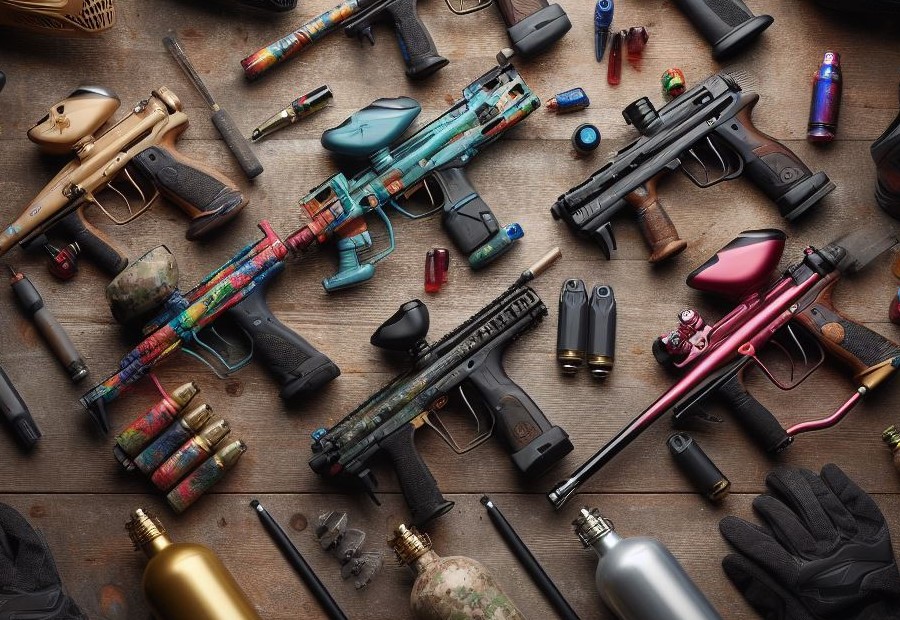
Paintball guns, also known as markers, is essential in enjoying the popular game of paintball. These recreational weapons use compressed gas, such as carbon dioxide or air, to propel paintballs at high velocities, ensuring a thrilling gaming experience.
One crucial aspect to consider is the power output of paintball guns. The velocity at which the paintballs are shot is regulated to guarantee player safety.
Most fields enforce a maximum velocity limit of approximately 280 feet per second, although this may vary. Adhering to these regulations is necessary to prevent injuries during gameplay.
Maintenance is another key factor to comprehend when it comes to paintball guns. Regular cleaning and lubrication are essential to keep the marker functioning properly and prevent any issues during gameplay.
It is crucial to follow the manufacturer’s instructions and guidelines to ensure the gun’s performance and longevity.
Moreover, there are different types of paintball guns available, including mechanical, electronic, and pump markers. These guns vary in their firing mechanisms and features, offering players options based on their preferences and gameplay style.
It is worth noting that understanding the limitations of paintball guns is vital for safe gameplay. Paintballs fired from these guns are not strong enough to break glass, making paintball a safe recreational activity for players of all ages.
How Do Paintball Guns Work?
Paintball guns operate by utilizing compressed air or CO2 to launch paintballs at high speeds. These guns have a barrel where the paintballs are loaded and a mechanism that generates pressure to propel the paintballs out of the barrel.
When the trigger is pulled, the air or CO2 is released, propelling the paintball forward with sufficient force to travel a considerable distance.
The paintball guns are equipped with a hopper that holds the paintballs and supplies them to the gun’s firing mechanism. As the air or CO2 is discharged, it expels the paintball out of the barrel, and the hopper automatically loads a new paintball for the subsequent shot.
Different types of paintball guns determine the firing mechanism and other characteristics. These include pump-action guns, semi-automatic guns, and fully automatic guns.
Each type operates differently, but they all rely on the fundamental principle of air or CO2 propulsion to propel paintballs.
Paintball was initially developed in the 1980s as a means for foresters to mark trees and livestock.
However, it quickly evolved into a popular recreational sport. Today, paintball is enjoyed by millions of people globally, both as a competitive sport and a fun outdoor activity. The advancements in paintball gun technology have enabled more precise shots and enhanced gameplay.
Safety precautions, such as protective masks and barrel plugs, have also been implemented to ensure player safety.
Whether playing professionally or casually, understanding the mechanics of how paintball guns work is crucial for a rewarding and successful game.
What Types of Paintball Guns are There?
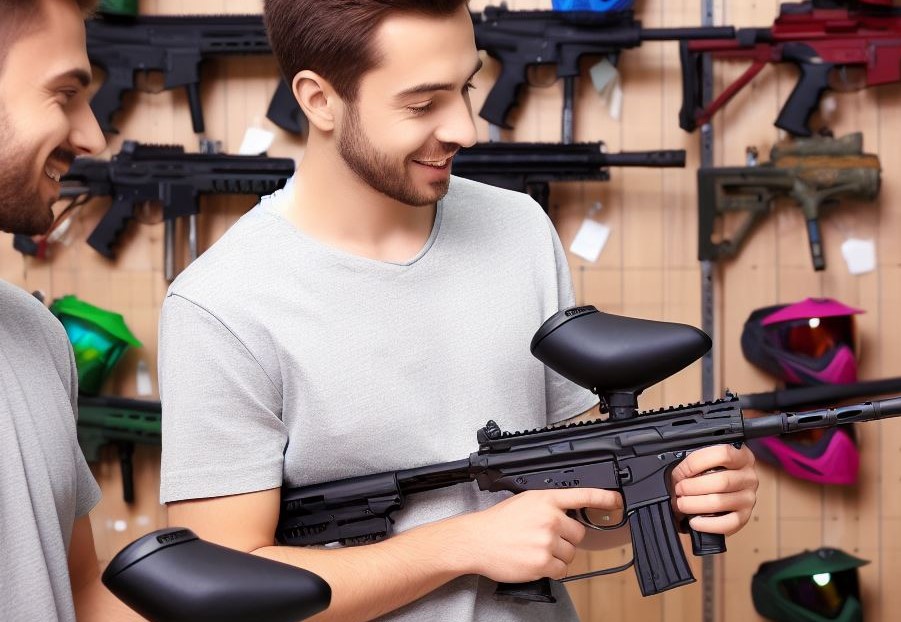
- Pump-Action: Paintball guns that require manual re-cocking after each shot are known as pump-action guns. They are appreciated for their simplicity and reliability.
- Semiautomatic: The most commonly used type of paintball gun in the sport is the semiautomatic. It operates with a single trigger pull that fires one paintball at a time.
- Electronic: Paintball guns that utilize a battery-powered circuit board to control the firing mechanism are referred to as electronic guns. They offer a higher rate of fire and customizable settings.
- Mechanical: Mechanical paintball guns, on the other hand, rely on mechanical components and springs to fire paintballs. They are more affordable and require less maintenance compared to electronic guns.
- Mag-Fed: Mag-fed paintball guns utilize detachable magazines to hold and feed paintballs. They provide a realistic mil-sim experience but have a lower ammo capacity.
- First Strike: First Strike paintball guns use specialized fin-stabilized rounds that offer increased accuracy and range compared to traditional paintballs.
When choosing a paintball gun, it is important to consider factors such as your playing style, budget, and the level of maintenance required.
Each type of paintball gun has its own advantages and disadvantages; therefore, it’s crucial to select one that suits your needs and preferences.
Can Paintball Guns Break Glass?
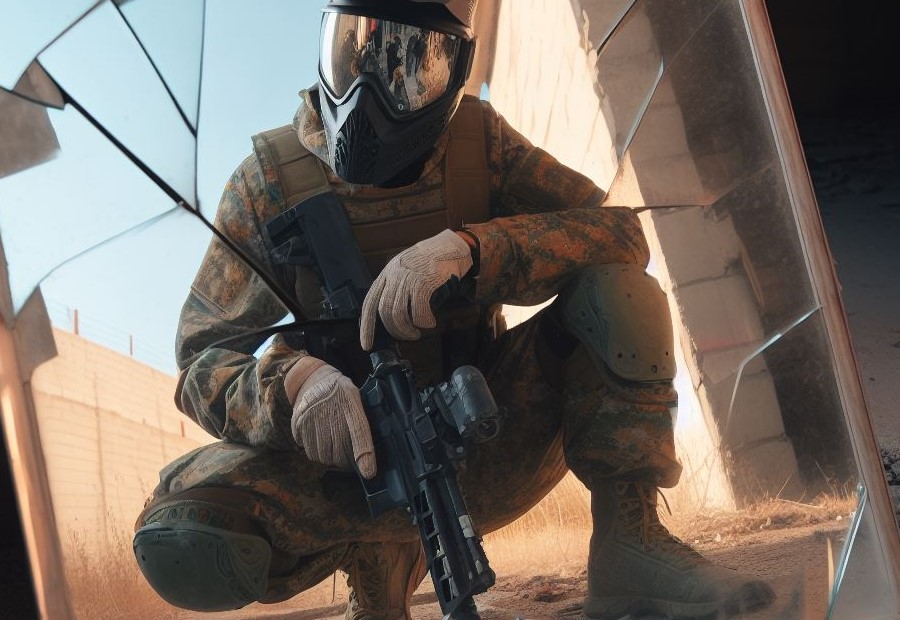
Paintball guns can indeed break glass. The sheer force behind a paintball has the potential to cause glass to shatter upon impact. When using a paintball gun near surfaces made of glass, it is imperative to exercise caution to prevent accidents or damage.
The velocity at which the paintball is shot also plays a role in the likelihood of glass breakage. It is important to note that higher velocities increase the chances of breaking glass, whereas lower velocities pose less risk.
Therefore, adhering to safety guidelines and regulations while operating paintball guns is crucial to avoid any unfortunate incidents.
It is highly recommended to refrain from shooting paintballs directly at glass objects in order to minimize the risk of breakage.
Instead, prioritize aiming at designated targets and promoting good sportsmanship.
Factors That Determine the Ability to Break Glass
When it comes to breaking glass with paintball guns, several factors come into play. These factors include the force delivered by the gun, the distance between the gun and the glass, and the type of glass being targeted.
- The force of the paintball gun plays a significant role. Different types and settings of paintball guns can generate varying amounts of force. Guns with higher force are more likely to break glass, while lower force guns may not have enough power to cause damage.
- The distance between the gun and the glass also plays a crucial role. As the paintball travels, its force decreases. Therefore, a point-blank shot is more likely to break glass compared to a shot from a distance.
- The type of glass is another important factor. Some types of glass are more prone to breaking than others. For example, tempered glass is designed to shatter into less dangerous pieces when it breaks. On the other hand, regular window glass may crack or break completely when hit by a paintball.
How Much Force Can a Paintball Gun Generate?
A paintball gun has the ability to generate a significant amount of force when it is fired. This force is measured in feet per second (fps), which is also how the force generated by a paintball gun is quantified.
On average, paintball guns can produce speeds ranging from 200 to 300 fps. It is worth noting that the velocity can be adjusted depending on the specific paintball gun being used and the user’s chosen setting.
Understanding the force that a paintball gun can generate is crucial in order to ensure safety when shooting near glass. When a paintball hits glass at a high velocity, the impact can potentially cause the glass to break.
The force exerted on the glass by the paintball is influenced by various factors, including the weight and velocity of the paintball, as well as the type and thickness of the glass.
To minimize the risk of glass breakage while using a paintball gun, it is recommended to use lower velocity settings and paintballs that are the appropriate size. This will reduce the force of impact and decrease the likelihood of glass breakage.
Additionally, implementing protective measures such as installing coverings or barriers can help prevent damage to glass surfaces.
It is important to always follow the safety guidelines provided by paintball manufacturers and organizers. Familiarize yourself with the specific velocity limits and regulations for the paintball gun you are using.
By doing so, you can ensure a safer and more enjoyable paintball experience while minimizing the risk of breaking glass.
Effect of Distance on Breaking Glass with Paintball Guns
The effect of distance on breaking glass with paintball guns is a significant factor to consider. When a paintball is fired from a close distance, it exerts a greater force on the glass, thereby increasing the likelihood of glass breakage.
On the other hand, as the distance between the paintball gun and glass increases, the force exerted on the glass diminishes, reducing the chances of the glass breaking.
It is crucial to understand that the force of impact decreases exponentially with distance. For instance, if a paintball is shot at a glass surface from a distance of 10 feet, it will have less force compared to shooting it from just 5 feet away.
Therefore, the farther the distance between the paintball gun and glass, the lower the risk of glass breakage.
To minimize the risk of breaking glass, it is highly recommended to maintain a safe distance when engaging in paintball activities near glass surfaces.
This can be achieved by utilizing the appropriate shooting range for paintball or ensuring that all players are fully aware of the potential risks involved and strictly adhere to safety guidelines.
What Type of Glass is More Prone to Breaking?
When it comes to determining what type of glass is more prone to breaking from paintball guns, tempered glass is more susceptible compared to other types of glass.
Tempered glass is designed to be stronger and more resistant to impacts, but it can still break under certain circumstances. It is commonly used in car windows, shower doors, and tabletops. However, the unique manufacturing process of tempered glass makes it prone to shattering into small, less dangerous pieces when broken.
Unlike regular glass, tempered glass undergoes a controlled heating and rapid cooling process, which enhances its strength. However, this process also creates internal stress within the glass, making it more vulnerable to breaking when impacted by a paintball.
Preventive Measures to Avoid Breaking Glass
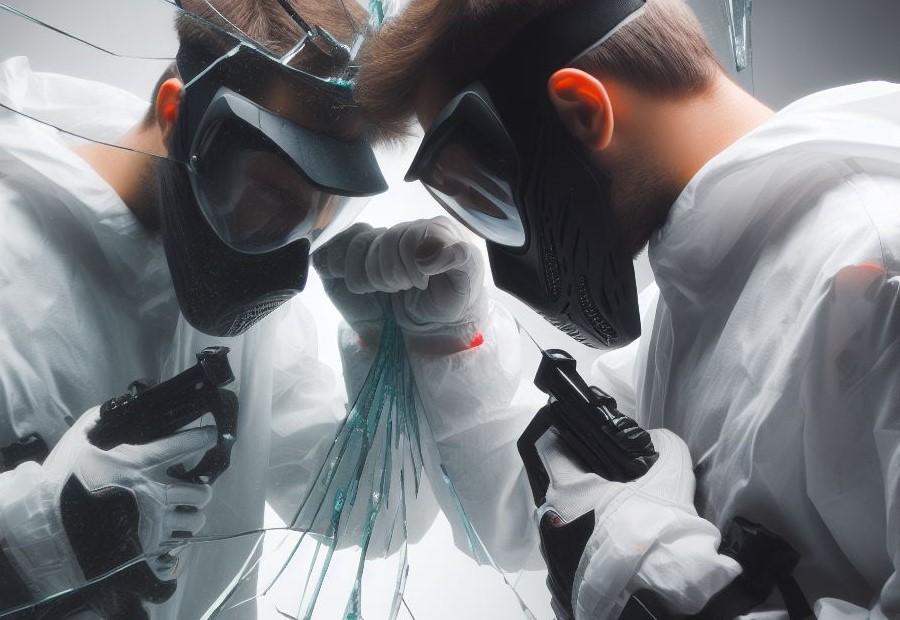
When it comes to paintball, nobody wants the exhilaration of the game to be spoiled by the sound of shattering glass. That’s why in this section, we’ll explore a range of preventive measures that can help you avoid any unwanted mishaps.
From utilizing lower velocity paintball guns to choosing the right type of paintballs and employing protective measures for glass surfaces, we’ve got you covered.
So, let’s dive in and ensure your paintballing experience remains fun, safe, and glass-breakage-free!
Using Lower Velocity Paintball Guns
When it comes to using lower velocity paintball guns, there are several important steps to consider:
- Adjusting the velocity of the paintball gun is crucial in order to reduce the force at which the paintballs are fired. This can be achieved by adjusting the regulator or modifying the spring tension.
- Opting for a barrel with a larger bore size is another effective method. This will effectively decrease the velocity of the paintballs and subsequently reduce the force they exert upon impact.
- The choice of lighter paintballs is also significant. By using lighter paintballs, the kinetic energy and impact force when fired are minimized, thus mitigating the risk of breaking glass.
- It is imperative to maintain a safe distance from glass surfaces to prevent accidental breakage. It is advised to keep a safe distance from glass windows, doors, or other fragile surfaces.
Using Properly Sized Paintballs
Using properly sized paintballs is crucial to prevent damage to glass when shooting a paintball gun.
Here are some important factors to consider:
- Accuracy: Incorporating the use of properly sized paintballs for your paintball gun will greatly enhance accuracy. This will effectively reduce the chance of unintentionally hitting the glass surface.
- Reduced Impact Force: Using paintballs that are sized correctly will significantly decrease the force upon impact. By doing so, it helps minimize the risk of breaking the glass surface.
- Less Friction: Properly sized paintballs will have a smoother trajectory through the air, reducing the likelihood of them bouncing off the glass and causing potential damage.
- Manufacturer Recommendations: It is essential to always adhere to the manufacturer’s guidelines regarding the appropriate size of paintballs to be used with your specific paintball gun model. Following their recommendations ensures optimal performance and greatly reduces the risk of damage.
By utilizing properly sized paintballs, you can enjoy the thrill of paintball shooting near glass surfaces without having to worry about unintentional damage or breakage.
Remember to prioritize safety and follow all recommended precautions to have a fun and safe paintball experience.
Choosing the Right Type of Paintballs

When it comes to choosing the right type of paintballs for your paintball gun, there are several factors to consider.
- First, you need to decide between regular paintballs and tournament-grade paintballs. Regular paintballs are perfect for casual play as they have a thicker shell. On the other hand, tournament-grade paintballs are specifically designed for competitive play and offer a thinner shell for improved accuracy.
- Another important factor is the size of the paintballs. You can choose between .68 caliber or .50 caliber paintballs. The larger .68 caliber paintballs are more commonly used as they provide a good balance of accuracy and impact. If you prefer a lighter option with less impact, especially suitable for younger players or those looking for a less intense game, then the .50 caliber paintballs would be a better choice.
- The fill type of the paintballs is also worth considering. Paintballs can have either oil-based or water-based fills. Water-based fills are more eco-friendly and easier to clean, while oil-based fills are more durable and can withstand harsher conditions.
- Lastly, it is essential to choose paintballs from reputable brands with a proven reputation for quality and consistency. Popular choices among players include Empire, GI Sportz, and Valken.
A helpful tip is to try out different types and brands of paintballs before purchasing a large quantity. This way, you can determine which ones work best with your paintball gun and suit your playing style.
Protective Measures for Glass Surfaces
When it comes to protecting glass surfaces from the impact of paintball guns, there are several protective measures that can be taken to minimize the risk of damage.
- Applying protective films: One effective protective measure is to apply special films or coatings to the glass surface. These films are designed to absorb the impact of paintball shots and prevent them from shattering the glass.
- Using polycarbonate shields: Another option is to install polycarbonate shields in front of the glass surfaces. Polycarbonate is a strong and impact-resistant material that can provide an additional layer of protection against paintball shots.
- Regular maintenance: Keeping the glass surfaces clean and in good condition can also help prevent damage. Regularly inspecting the glass for any signs of wear or weak spots and addressing them promptly can reduce the risk of breakage.
- Creating a buffer zone: If paintball activities are taking place near glass surfaces, it is advisable to create a buffer zone to minimize the chances of accidental shots hitting the glass. Setting clear boundaries and ensuring players are aware of the proximity to glass can help prevent accidents.
By implementing these protective measures for glass surfaces, the risk of damage from paintball guns can be significantly reduced, ensuring the safety and longevity of the glass.
Frequently Asked Questions
Can paintball guns break glass?
Yes, paintball guns have the potential to break glass depending on several factors such as the type and thickness of the glass, the speed of the paintballs, and the angle at which they hit the glass.
What type of glass is the most resistant to paintball damage?
Tempered glass is the strongest and least likely to break when hit by a paintball. It is commonly used in vehicle windows and offers better resistance to paintball damage compared to other types of glass.
Can regular house windows withstand paintball impact?
Most regular house windows, especially those made with annealed glass, are more susceptible to breaking when hit by paintballs. It is recommended to avoid shooting paintballs at windowpanes, as they may cause damage.
Do paintballs have the potential to break car windows?
Yes, paintballs can break car windows depending on factors such as the weight of the paintball, length of the barrel, speed of the wind, air density, and temperature. Lighter paintballs with higher velocity are more likely to cause damage to car windows.
Are frozen paintballs more likely to break glass than regular paintballs?
Yes, frozen paintballs have a better chance of breaking glass compared to regular paintballs. Freezing paintballs using dry ice or liquid nitrogen can make them more brittle and prone to shattering upon impact.
Is it dangerous to play paintball near windows or other glasses?
It is best to avoid shooting paintballs at windows or other glasses as it can lead to damage and potential injuries. Taking precautions by playing paintball in open fields away from vulnerable glass objects can help prevent accidents.

